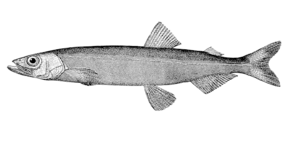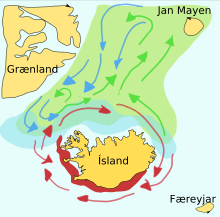Capelin facts for kids
Quick facts for kids Capelin |
|
|---|---|
 |
|
| Scientific classification | |
| Genus: |
Mallotus
|
| Species: |
villosus
|
The capelin (Mallotus villosus) is a small fish. It belongs to the smelt family. You can find capelin in the North Atlantic, North Pacific, and Arctic oceans.
In summer, capelin eat huge groups of tiny sea creatures called plankton. They also eat krill and other crustaceans. Many animals hunt capelin. These include whales, seals, Atlantic cod, Atlantic mackerel, squid, and seabirds. They are especially hunted during their spawning season.
Capelin lay their eggs on sand or gravel bottoms. They also lay eggs on sandy beaches. They usually spawn when they are two to six years old. When they spawn on beaches, almost all the males die afterward.
Male capelin grow to about 20 centimeters (8 inches) long. Females can be up to 25.2 centimeters (10 inches) long. They are olive-colored on top and silver on their sides. Males have a clear ridge on both sides of their bodies. Their undersides turn reddish when they spawn.
Where Capelin Travel

Green shade: Feeding area of adults
Blue shade: Distribution of juveniles
Green arrows: Feeding migrations
Blue arrows: Return migrations
Red shade and Red arrows: Spawning migrations, main spawning grounds and larval drift routes

Capelin populations in the Barents Sea and near Iceland travel long distances. These are called seasonal migrations.
Capelin from the Barents Sea move to the coast of northern Norway and Russia in winter. They go there to lay their eggs. In summer and autumn, they travel north and northeast to find food.
Icelandic capelin swim closer to shore in big schools to spawn. In spring and summer, they travel to feed. They go to areas rich in plankton between Iceland, Greenland, and Jan Mayen.
Where capelin live and travel depends on ocean currents. Around Iceland, adult capelin usually swim north in spring and summer to feed. They return south from September to November. Their journey to lay eggs starts in December or January from north of Iceland. Scientists can even predict their spawning routes!
How Capelin Reproduce
Capelin have many babies. They lay their eggs, which is called spawning. Their main spawning season is in spring, but it can last into summer. Most capelin are three or four years old when they spawn for the first time.
Males swim directly to shallow water in fjords. This is where they will spawn. Females stay in deeper water until they are ready to lay eggs. Once ready, they swim to the spawning areas. This usually happens at night.
In the North European Atlantic, capelin typically lay eggs on sand or gravel. This happens in water from 2 to 100 meters (7 to 328 feet) deep. But in the North Pacific and near Newfoundland, most capelin spawn on beaches. They jump as far onto the land as they can. Some even get stuck on the land.
Jumping onto land in large groups to spawn is very rare. Only capelin, grunions, and grass puffers do this. After female capelin lay their eggs, they leave the spawning grounds. If they survive, they can lay eggs again in future years. Males stay on the spawning grounds. They might spawn more than once during the season. However, male capelin usually die soon after the spawning season ends.
Capelin Fishing

Capelin are an important food source for other animals. They are a key food for the Atlantic cod. Because of this, Norway and Russia manage fishing for both cod and capelin together.
Sometimes, there are many Atlantic herring in the Barents Sea. When this happens, capelin populations can drop. This might be because herring compete for food. Herring also eat young capelin. But sometimes, capelin numbers are good even with many herring. This shows that herring are only one thing that affects capelin.
In Quebec and Newfoundland and Labrador in Canada, locals often go to the beach. They scoop up capelin in nets when the fish "roll in." Millions of capelin come to the beaches each year in late May or early June.
People use capelin to make fish meal and fish oil. But they are also eaten by people. The meat tastes good, similar to herring. Capelin roe (eggs), called masago, is a valuable product. It is sometimes mixed with wasabi or green food coloring. This is sold as "wasabi caviar." Often, masago is sold as ebiko. It is used instead of tobiko, which are flying fish eggs. This is because they look and taste similar. However, masago eggs are smaller and less crunchy than tobiko.
See also
 In Spanish: Capelán para niños
In Spanish: Capelán para niños

